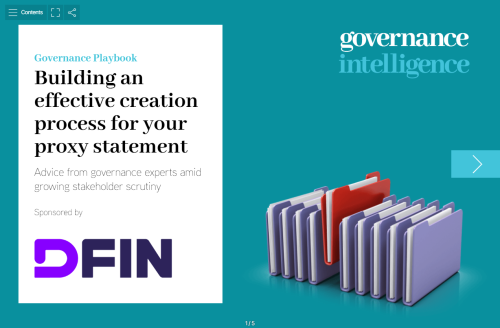June and July are best time for boards and corporate secretaries to start planning off-season investor outreach
With the peak of proxy season in the rear-view mirror, companies and investors are analyzing takeaways from the thousands of meetings that have occurred over the past three months. Although most US companies received strong support from shareholders at their annual meeting, others have faced low levels of support for executive compensation or directors or high levels of support for a shareholder proposal.
Whether this year’s proxy season was placid or turbulent for your company, June and July are the best time for boards and corporate secretaries to start planning for off-season investor outreach that will provide a path to success in 2018. Here are four steps that will yield dividends before your next annual meeting.
Analyze your vote, but also investor sentiment
The first few weeks after your annual meeting are prime time to take stock of annual meeting votes and outcomes while everything is fresh in the mind of the board and management team. One common mistake made during this period is to focus only on vote totals. Well-prepared companies look beyond raw numbers to understand the factors that drove the level of shareholder support and examine any misalignment between what investors said during engagement efforts leading up to the annual meeting and what their vote was.
If your company received very high votes against management on any items, it may be helpful to reach out to major investors to reassure them the board has heard investors’ perspectives and will have more to share in the coming months. But if this year’s meeting went well, forgo any additional calls to governance teams while they continue to vote on hundreds more meetings before the end of June. Instead, use this time to reflect on feedback received before the meeting and any nuances that may be embedded in the vote results.
Make sure your board knows what shareholders are saying
The immediate postmortem of an annual meeting should include a detailed report for your board and management team on shareholder feedback as well as any meaningful investor trends that emerged during proxy season. Even high-level feedback from your largest shareholders can help identify themes that may indicate challenges or pressure points that could be on the horizon.
If you didn’t have a chance to speak with all of your large holders, look for recent public statements on issues that may be relevant. Board members often appreciate updates that can help put a company’s practices and outcomes in the context of the broader marketplace and peers.
Plan ahead for the fall
Companies that have the most productive shareholder engagement programs are disciplined about linking earlier feedback and votes to agenda items for subsequent engagements. As you start planning, keep your board’s meeting calendar in mind to ensure you’ve built in sufficient time to first gather and then integrate shareholder feedback into discussion of any potential governance or compensation changes. Another date to keep in mind is August 31, when mutual fund and exchange-traded fund votes are made public in Form N-PX reports.
A major topic of discussion this fall will be the changing shareholder and regulatory landscape. This past proxy season will be remembered for the unprecedented level of shareholder support for climate-related proposals; that trend is unlikely to go away as investors increasingly view sustainability as part of a company’s governance mandate.
In addition, anticipating what’s on the horizon for new leadership at the SEC, as well as potential legislation that could impact the relationship between investors and companies, will help your board stay nimble. The political process is often unpredictable, which makes it imperative to prepare for the range of outcomes and to share your company’s voice in the policy development process where appropriate.
Recognize that the off-season is becoming the new busy season
As more and more companies see the benefits of engaging with their largest investors throughout the year, securing meetings during the off-season has become nearly as competitive as it is in-season. Major institutional investors have increased the size of their governance teams, but demand for engagement is still outstripping capacity.
Companies need to be thoughtful and focused not just about the topics they are seeking to meet about, but how they approach getting those meetings in the first place. Advance planning is essential to ensure investor conversations are productive and valuable for both companies and investors. An effective off-season engagement cycle can set a positive tone for 2018 and decrease the chances you’ll be surprised at your next annual meeting.
For companies that experienced low levels of support or opposition to management at this year’s annual meeting, the period immediately thereafter can feel like starting at the bottom of a mountain. If this is your company’s first time facing an investor challenge, take comfort that your advisers have likely seen this situation before and can help you formulate a response. Now is the time to huddle with your internal teams to start discussing next steps and engage with your advisers to help find the most effective path forward.
Krystal Gaboury Berrini is a partner at CamberView Partners.








